Alert Level 3 – Restrict: 28 April – 14 May 2020
Risk: High risk the disease is not contained
New Cases: 29
Range of Measures:
- People instructed to stay home in their bubble other than for essential personal movement – including to go to work, school if they have to, or for local recreation.
- Physical distancing of two metres outside home (including on public transport), or one metre in controlled environments like schools and workplaces.
- People must stay within their immediate household bubble, but can expand this to reconnect with close family / whānau, or bring in caregivers, or support isolated people. This extended bubble should remain exclusive.
- Schools (years 1 to 10) and Early Childhood Education centres can safely open, but will have limited capacity. Children should learn at home if possible.
- People must work from home unless that is not possible.
- Businesses can open premises, but cannot physically interact with customers.
- Low risk local recreation activities are allowed.
- Public venues are closed (e.g. libraries, museums, cinemas, food courts, gyms, pools, playgrounds, markets).
- Gatherings of up to 10 people are allowed but only for wedding services, funerals and tangihanga. Physical distancing and public health measures must be maintained.
- Healthcare services use virtual, non-contact consultations where possible.
- Inter-regional travel is highly limited (e.g. for essential workers, with limited exemptions for others).
- People at high risk of severe illness (older people and those with existing medical conditions) are encouraged to stay at home where possible, and take additional precautions when leaving home. They may choose to work.
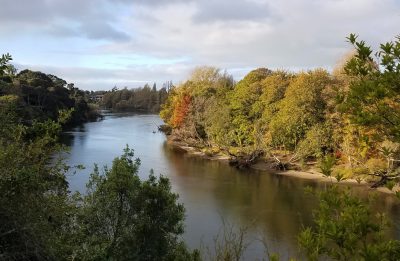
Many of our additional daily walks took us along the Waikato River with its incredible green space that hides the fact that you are in the middle of Hamilton
During our customary walk between 7 and 8 o’clock on the morning of Tuesday 28 April, the day New Zealand’s COVID-19 restrictions were reduced from Level 4 to Level 3, we noticed more traffic on the roads and more noise emanating from construction sites around our neighborhood as many “nonessential” workers returned to their jobs. But for us and the other senior missionaries assigned to the Church History Department, not much had changed. A business executive we heard interviewed on Radio New Zealand summed up the feelings of white-collar workers like us when she described Level 3 as “like Level 4, but with take-away.”
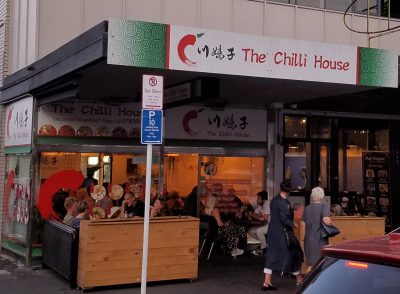
Chili House pre-take-away
Barry was happy to hear that “with take-away” would be a feature of Level 3. About 4:00 that first afternoon, he called to let us know that Chilli House had reopened for take-away customers, and proposed that he go pick up a Chinese dinner for the four of us. We could declare ourselves “extended family,” thus becoming eligible to expand our isolation bubbles to include each other’s household, and celebrate this day of reduced restrictions together. So while he and Eva went into Hamilton’s Central Business District to pick up a couple of orders of noodle salad and our favorite fried dumplings, Michael set four places at our little all-purpose table and Nancy made some cabbage salad to round out the meal. When Barry and Eva arrived with the food, we felt slightly seditious allowing them to cross our threshold, but it was wonderful to be able to enjoy face-to-face conversation across the same table again. We played a round of “Spicy Farkle” (a higher-stakes variation than regular Farkle) and then for dessert, savored the apple crisp Diane had baked in a variety of op-shop ramekins and delivered to each senior-missionary household earlier in the day. Barry was grateful that we happened to have half a bottle of thick cream to pour over the top.
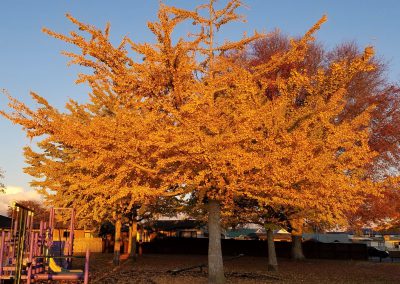
Evidence that May in the southern hemisphere is in the middle of autumn
Although the government was allowing anyone who could not work from home to return to their workplaces, the leadership of The Church of Jesus Christ of Latter-day Saints was not allowing anyone into its facilities except security personnel; thus we were still locked out of the Matthew Cowley Pacific Church History Centre. For most of our cohort, this was fine, but for Sister E it was a continued frustration. With access to neither her photographic equipment nor the historical documents she was supposed to be digitizing, the only work she could really do from home was indexing, and trying to index eight hours a day five days a week was becoming tedious. In virtual meetings with Jared, our advocate in the Church’s Pacific Area office, we frequently discussed the desirability of getting Diane back into the Records Preservation Centre so she could start scanning again, but Church leaders always responded with “an abundance of caution”: in other words, it might still be weeks before anyone could return to work in the MCPCHC.
Most of Michael’s work hours during the weeks we spent at home were consumed by a structural analysis of the MCPCHC’s digital filing system, and then by the creation of a graphic presentation designed to help our Church History Department supervisors in Salt Lake City understand the unique challenges of dealing with the condition of the Kia Ngawari Trust collection (see our post for 12 June for an explanation of that). He and Eva spent days discussing possible ways to begin disentangling it, but every potential solution was dependent on persuading the people in Salt Lake to rethink their own cataloging protocols—an uphill battle. Nevertheless, Michael and Eva persisted, constantly refining the PowerPoint presentation until every point was perfectly clear.
Meanwhile, Nancy had begun drafting display text for the new museum exhibit for 2021, “Sacrifice and Consecration: The Building of the Hamilton New Zealand Temple,” but by the end of April there was still a lot of research to be done. Because one section of the exhibit will focus on people from other Pacific nations who made significant personal sacrifices to travel to New Zealand to attend the temple, Nancy had to actively seek out their stories.
For example: The Church History catalog includes a photo of the first couple from Papua New Guinea to receive their temple ordinances, but nothing about what it took for Brother and Sister R to get from PNG to New Zealand when they made the trip in 1984. By searching the Church Directory of Leadership and Organizations, Nancy was able to determine that Brother R is currently serving in the presidency of the Papua New Guinea Port Moresby Mission, so on 5 May she sent an email message to the mission office to ask if he would contact her to answer some questions. She was surprised and pleased to almost immediately receive a call from the mission president, who told her that contacting Brother R would be difficult because he lives in a remote village with no telephone and no internet.
“But he happens to be coming into Port Moresby tomorrow for a meeting,” the president said, “so I’ll have him call you from the office phone when the meeting is over.”
This was great news—except that now Nancy would have to prepare to conduct and record a phone interview by lunchtime the next day. Fortunately, Elder and Sister T, the oral history specialists, had taken their recording equipment home when we had to vacate the MCPCHC, so Wendy agreed to bring the audio recorder to our flat the next morning. We “unzipped our bubble” and let her in so she could show us how to operate the equipment and give Nancy some tips for doing a phone interview. When the call came through a few hours later, we were ready.
Brother R’s English was easier to understand than Nancy had dared hope, and he graciously agreed to answer her questions. However, he asked if she would mind if he responded later, in writing, because he wanted to talk with his wife about their shared experience so that her memories could be included in the story as well. Nancy gladly agreed to that plan—happy that Sister R’s perspective would be represented, and relieved that she wouldn’t have to transcribe quotations from an audio recording.
Gathering material for Nancy’s other major project while working from home—the first chapters of the Auckland Temple history—presented more challenges. Digital resources and the print books she had brought home contained plenty of information about the history of The Church of Jesus Christ of Latter-day Saints in New Zealand through the 1970s, but little about what had happened more recently—and even less about how Church members in Auckland had demonstrated that they were ready for a temple of their own. Nancy and Barry assembled a list of current and former Auckland-area stake leaders who were potential sources of information, tracked down their contact info, and then gave the list to Ross and Barbara, chairs of the Historical Subcommittee for the groundbreaking, so they could email or ring them. The process produced a trove of useful facts, but it also produced four or five lengthy audio recordings from which Nancy had to painstakingly transcribe quotations. Nancy decided to contact two of the men on her potential sources list herself rather than asking Ross and Barbara to do so because she had her own connection with them. These were the sons of the Auckland Stake’s first Kiwi president, who also happened to be the father and uncle of our friend and former Montgomery Ward Relief Society president Jan B. As each reminisced about their father and their own church experience as they were growing up, they provided Nancy with some valuable information about the Auckland Stake’s early years.
Even though Nancy was not a member of the actual Auckland Temple Groundbreaking Committee, as a member of the Historical Subcommittee she was invited to participate in a virtual committee meeting on the afternoon of Sunday 17 May. It was nice to be able to see and hear people she had communicated with only via email, but even more interesting to observe the interactions among people who obviously knew each other well. Most of the meeting was consumed with a review of plans should only ten people be allowed to attend the groundbreaking ceremony on 13 June; plans should only fifty be allowed; and plans for up to a hundred. No one could anticipate which plan to set in motion until 26 May, when Jacinda Ardern was scheduled to announce a potential reduction in COVID-19 restrictions. About an hour into the committee meeting, the parking logistics coordinator announced that he had just received a message from Auckland Transport informing him that a roadwork project was set to begin on Redoubt Road adjacent to the temple site, beginning that day and scheduled to last four weeks—beyond the date of the groundbreaking. The message also included a request: Could Auckland Transport use the Church’s car park for their heavy road-building equipment after work hours? That wouldn’t be a problem if only ten people were allowed to attend the Saturday morning temple groundbreaking ceremony, or even fifty, but what if a hundred or more people needed to find parking spaces? The only thing anyone could be certain of was that little was certain about how this groundbreaking event would finally proceed. Nancy was glad that although her history-writing assignment had its challenges, the basic parameters were not subject to change according to the number of people who could come.
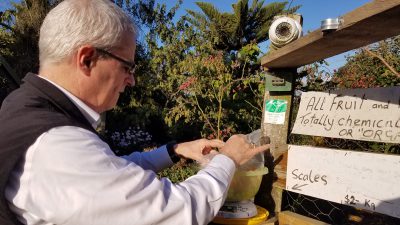
Weighing our purchase at a self-serve fruit and vegetable stand south of Temple View
Between work sessions on our various Church history projects, we tried to bring our blog up to date, watched new installments of the Book of Mormon video series, chatted with distant friends and family (including Michael’s brother Phillip, who lives in France), and continued our daily walks around Hamilton. One day we visited the serve-yourself produce stand at a small farm up the road from the temple. By early May, the harvest had begun to dwindle—no more persimmons or quinces, but there were still a few apples and a bin full of feijoas. We didn’t need to buy any of the latter because people kept giving them to us.
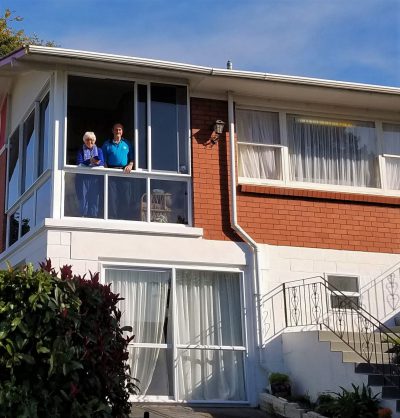
Rangi and Vic enjoying our birthday street party from a safe distance
Michael used a number of feijoas to make a cake for Rangi’s birthday in early May. Barry had suggested that in lieu of our regular virtual staff devotional that day, we all line up in the street outside Rangi’s house at 10 a.m. to sing “Happy Birthday.” Word had spread to the mission president’s wife and daughter, who live up the street from Rangi and Vic, so they came out and joined us. Rangi had become accustomed to joining our virtual devotionals while sitting in her sunroom overlooking the street (and the temple beyond), so at the appointed time, Barry phoned and advised her that instead of looking at her tablet for the devotional, she should look out the window. She was genuinely surprised and pleased to see so many of us strung out along the street to wish her a happy birthday—each person maintaining 2-metres distance from the next, of course. Michael delivered the feijoa cake to the doorstep, along with a slice of Nancy’s quince membrillo; Wendy and Alan had brought balloons, and others had made cards and posters. It was a fun diversion for all of us.
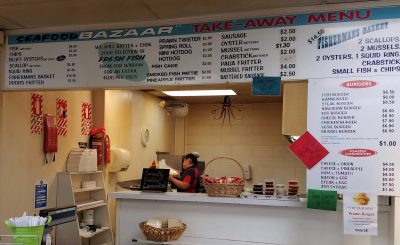
Seafood Bazaar, open for take-away only
Although most of our day-to-day activities under Level 3 weren’t too different from those under Level 4, the slight relaxation of restrictions allowed some significant changes. Including Eva and Barry in our isolation bubble meant that we could resume getting together for dinner and games periodically, which we did. We may not have been able to go out to eat, but we could still enjoy take-away restaurant fare. One night Michael offered to pick up a pizza, a process that involved calling in the order, arranging a pick-up time, and then waiting for someone to slide the box across a table set up in Avalon Pizza’s open doorway, which was partially covered with plastic wrap to ensure physical distancing between employees and customers. Another night, Michael and Barry went together to pick up dinner from Thai Takeaway, but Eva and I were surprised to see them come back empty-handed only ten minutes later. They had decided to return after placing our order because Nham, the proprietor, was so busy she wouldn’t be able to have our coconut curry soup and massaman chicken ready for at least 40 minutes—but we decided it was worth the wait. And it was a great day when Barry learned that Seafood Bazaar finally had opened a drive-thru window. This is a fish market that will batter and fry a generous portion of the fish of your choice on the spot and serve it with so many chips that a single order can satisfy at least three people. Snapper is a favorite, but New Zealand offers a lot of other tasty varieties we have never seen in the States: gurnard, lemonfish, gemfish, and kingfish among them.
Alert Level 2 – Reduce: 14 May -8 June 2020
Risk: The disease is contained, but community transmission remains a possibility.
Golden Rules for Business
- Reduce the risk of COVID-19 transmission at work.
- All businesses can operate if they can do so safely. Alternative ways of working are encouraged where possible.
- Talk with your staff to identify risks and ways to manage them.
- Ask everyone — workers, contractors and customers — with cold or flu-like symptoms to stay away from your premises.
- Keep workers 1 metre apart and customers in retail businesses 2 metres apart.
- Businesses are legally required to display a QR code and provide an alternative contact tracing system.
- Face coverings are strongly encouraged if you are in close contact with others.
- Reduce the number of shared surfaces, and regularly disinfect them.
- Wash your hands. Wash your hands. Wash your hands.
On Thursday 14 May, New Zealand began phasing into Level 2, with retail stores, malls, restaurants, movie theatres, and other public spaces allowed to reopen as long as everyone agreed to wear masks, sanitize regularly, maintain physical distancing, and provide contact tracing information at every venue they entered. Schools could reopen under the same guidelines the following Monday, but other gatherings were still limited to ten people.
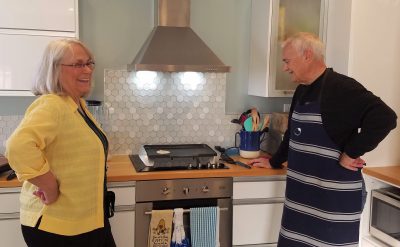
Diane and Barry cooking pancakes for our Bubble-Bursting party

Blowing bubbles outside at our Bubble Bursting party
On the Saturday after the announcement, Barry and Eva hosted a “Bubble-Bursting Breakfast’ for the seven full-time missionaries serving at the MCPCHC. It was the first time all of us had been together in the same indoor space for 52 days. Barry and Eva served pancakes, supplemented with two types of smoothies (banana-chocolate and feijoa) whipped up by Wendy and Alan. For entertainment, Nancy debuted a new song parody, and then we all went outside to blow and burst bubbles created with the giant wand Wendy had brought for the occasion.
Once gatherings of less than ten were officially permitted, our cohort began physically meeting together on Sundays for sacrament services and gospel discussions based on the Church’s weekly Come, Follow Me curriculum. The first of these was held at Barry and Eva’s house on Sunday 17 May and was followed by a “linger longer” lunch. We decided that we might as well meet the next day for Family Home Evening, too, since no one anticipated going on an extended P-Day excursion; travel outside our districts was still prohibited. Michael and Nancy hosted the gathering, where we reviewed and discussed the Proclamation on the Restoration of the Fulness of Gospel of Jesus Christ that had been presented at the Church’s general conference in April, and then enjoyed sharing the Apple Bavarian Torte we hosts had made earlier in the day.
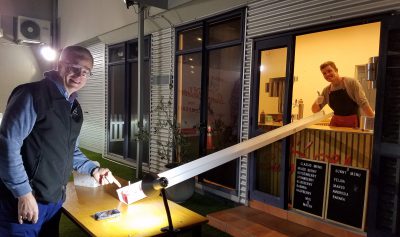
Our enterprising friend Josh, owner and operator of Sunny Nelson Real Fruit Ice Cream, utilized a length of rain gutter to safely and efficiently deliver his product before he was allowed to let customers back inside the shop
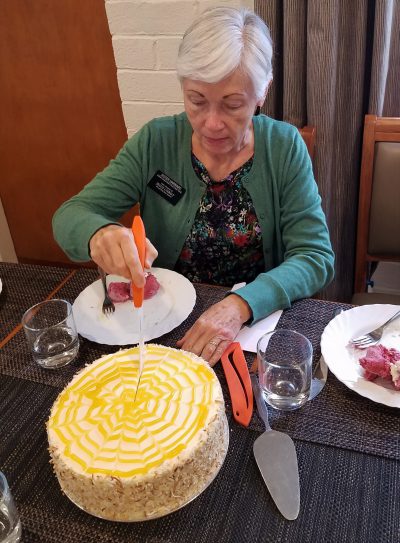
Nancy and her birthday cake
Nancy’s birthday fell on the following Sunday, so after our worship service at Barry and Eva’s house we celebrated with another group lunch, topped off with a superb lemon-raspberry cake that Barry had ordered from The Cake Box. Wendy brought birthday candles, and Michael had picked up two complementary flavors of frozen yogurt (coconut and mixed berry) from Sunny Nelson to add to the festive fare.

The Sharing Shed
Even though hair salons had reopened under Level 3, Nancy waited until the day after her birthday to get a haircut not only because she wanted to allow someone more desperate the opportunity for a turn in the barber chair, but also because many hair salons offer a 20-percent discount to senior citizens age 65 and over. So, once she was certifiably 65, Nancy went to The Base, Hamilton’s largest shopping center, put on a mask, and walked up to The Sharing Shed (a salon whose name makes more sense when you remember that Kiwis pronounce sharing as “shearing”). She had to chill outside in the rain for a few minutes after signing in because only one customer at a time was allowed in the waiting area. Peering through the glass, she tried to determine how well the shop was handling health and safety requirements. All the stylists were wearing masks, and everyone was using hand sanitizer and maintaining as much physical distance as possible, but it was hard to tell whether equipment was being adequately disinfected between customers. Nevertheless, when the manager beckoned Nancy inside, she didn’t hesitate.
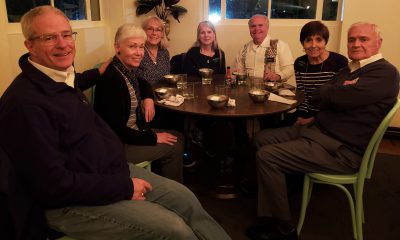
We celebrated the reopening of restaurants in Level 2 by going to Madam Woo’s
The mask seemed to render Daniel, the Korean stylist who had given Nancy her first haircut in New Zealand, less talkative than usual. Back in January, he had asked her how long she had been a member of “the Mormon Churchee” and then, after identifying himself as a Christian, tried to convince her that in the Second Coming, Jesus would return to earth as a baby—but this time he would have a different mother. Nancy was thankful that Daniel’s hair-cutting skills were more orthodox than his theology. However, she was sorely disappointed when the cashier refused to give her the senior citizen discount because even though she could prove she was a senior, she could not prove that she was a citizen. Apparently the discount is available only for SuperGold Card holders, and one must be a citizen or legal resident of New Zealand to qualify for a SuperGold Card.
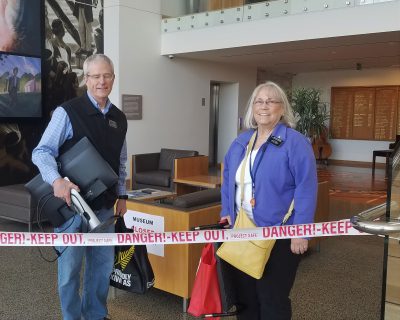
Moving Diane back into the Centre
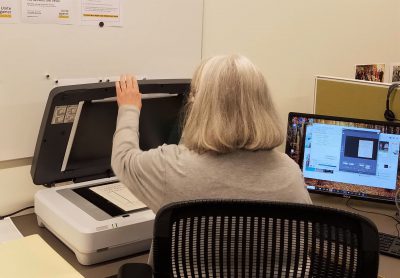
Diane at work with her commercial quality scanner
With so many public buildings reopening and most people returning to work, it became imperative to determine whether the staff of the MCPCHC could be among them. Leaders of The Church of Jesus Christ of Latter-day Saints had indicated that the Church would adhere to local government regulations, but would act more conservatively as those restrictions were lifted. They specified that the Church would not ease its own restrictions until at least two weeks after government rules were relaxed. There seemed to be no reason, however, to keep Diane from returning to the Centre so she could resume digitizing documents, especially if she was the only one laboring in the workroom. After many virtual meetings with Jared—who was having many more virtual meetings with Church History Department administrators in Salt Lake City, as well as with members of the Pacific Area presidency in Auckland—Sister E finally received permission to return to the workroom two days a week. Michael thus began the reverse process of removing computer equipment from Diane’s flat and reinstalling it at the Centre.
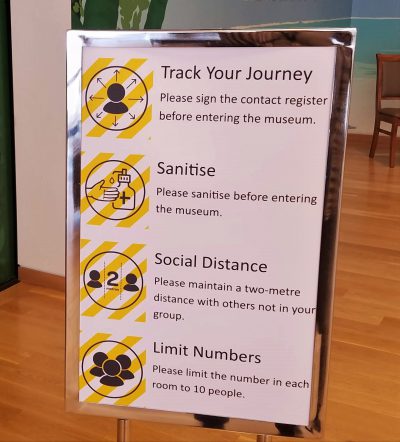
Our COVID signage
Our meetings with Jared also included much discussion about what needed to happen once we received clearance to reopen the MCPCHC to the public. There were so many questions: Would all staff and visitors be required to wear masks? If so, who would provide them? Who would be responsible for providing hand sanitizing stations in the Mendenhall Building? How would visitor information for contact tracing be collected? How many people would be allowed in the museum at once? How would we limit the numbers, and ensure that visitors maintained appropriate physical distance? What new cleaning protocols would we need to develop? Perhaps most important: Could we expect our volunteer docents, for whom exposure to COVID-19 carried significant risks because of their age and pre-existing medical conditions, to return to work at the museum? And if not, who would monitor visitors and ensure their compliance with all regulations? Because no one had ever been through anything like this before, we had nothing but our own imaginations to provide the answers.
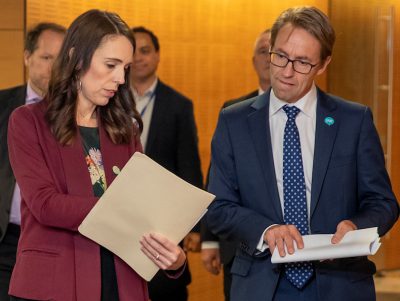
Ardern and Bloomfield prepping for their announcement
On 25 May, Jacinda Ardern and Ashley Bloomfield, New Zealand’s Director General of Health, announced that beginning at noon on Friday 29 May, gatherings of up to a hundred people would be allowed. They also indicated that a decision about possibly moving to Level 1—which basically meant resuming normal life within closed borders—would be made no later than 22 June. (Because it went so well they ended up making the decision that we would move to Level 1 on 9 June.) Two days later, we received word that the Area Presidency had decided to reopen the entire Mendenhall Building—the Distribution Centre, the Hamilton Mission offices, the Facilities Management offices, the Self Reliance offices, and the Matthew Cowley Pacific Church History Centre, including the museum—not only to those of us who work there, but to the public, beginning Tuesday 2 June. So on Thursday 28 May, immediately following our virtual devotional meeting, the full-time Church History missionaries unhooked all the office equipment we had been using at our flats during the past two months and took it back to the MCPCHC.
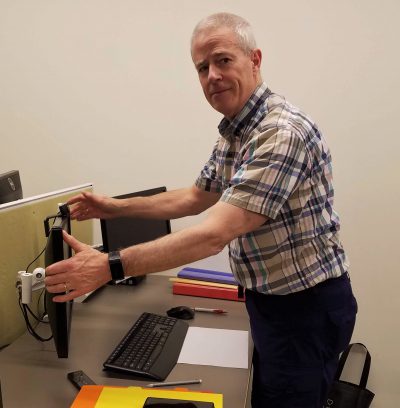
Michael helping to set the office back in order
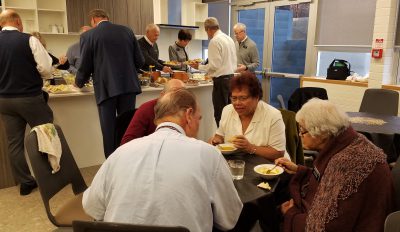
Moving to Level 2 allowed us to start holding our monthly senior missionary Break-the-Fast potluck dinners again
While Michael helped everyone reinstall their computers, Nancy applied for the required contract-tracing QR code on behalf of the Matthew Cowley Pacific Church History Centre. She then downloaded and printed official signage from the Updates and Resources section of the New Zealand government’s COVID-19 website, which she posted in every area of the building under Church History jurisdiction. The posters reminded visitors to either use the QR code or sign the contact-tracing register, sanitize their hands before entering the museum, and maintain 2-metres distance with anyone outside their own family group. That done, she contacted all the volunteer docents to inform them that the museum would be reopening on 2 June, but that their services would not be required until further notice. Rather than asking our senior citizens to put themselves at risk of infection, Barry and Eva had been inspired to enlist some of the younger full-time missionaries who had been recalled to New Zealand from overseas service to fill in as museum monitors. That would give our older docents at least a few more weeks to decide whether they felt comfortable coming back to confront the public again—and keep the young missionaries out of trouble and feeling useful while they awaited reassignment. A win-win situation for everyone!
And so our COVID-induced 64-day period of working from home came to an end. All of us admitted that although it would be good to return to normal—or to our “new normal,” anyway—we would miss the flexible schedule and the later start of each work day; the freedom to leave our workstations and go for a long afternoon walk; the ability to focus on research and analysis without the distraction of museum visitors; extra time to bake bread, try new recipes, read, write, and virtually visit with family and friends on the other side of the world. As we reflected on all the ways we had been blessed during what we initially regarded as imprisonment, we thanked the Lord for his tender mercies. Those 64 days of confinement truly had been a gift.
Praying for continued blessings for both of you that may continue to stay healthy and have inspiration to continue with your mission.
Thanks so much for sharing this. You are lucky to be in sensible, safe New Zealand. Blessings upon you!
You two remain constantly fully engaged in the Lord’s work. As always you are both excellent examples. Our cases of Covid here in Arkansas continue to climb and we pray daily for relief. Joe and I have remained isolated since February!!! We have learned much and have so much for which to be grateful. Joe’s the best pal ever and keeps me sane! I LOVED the pictures you posted and felt like I was right there with the two of you. Keep up the good work and know how very much the two of you are loved!!!